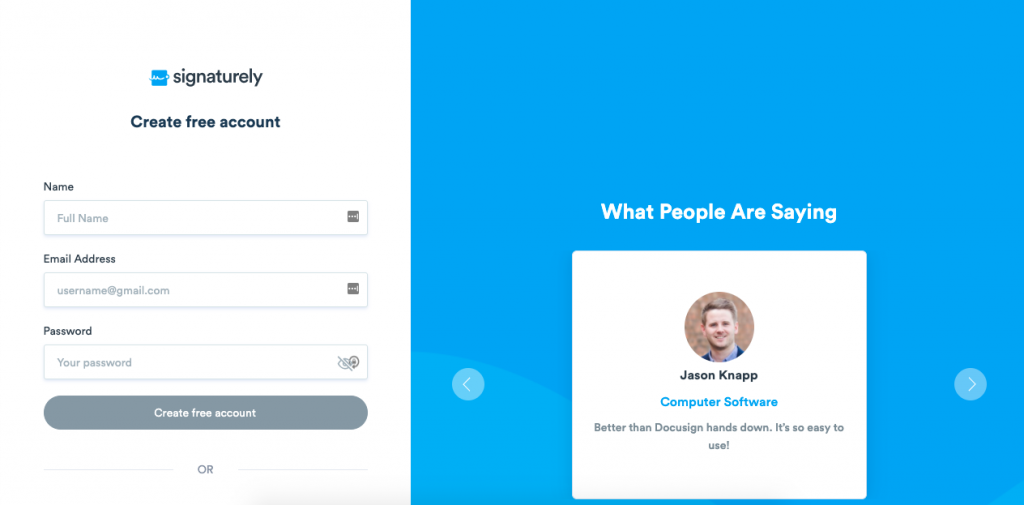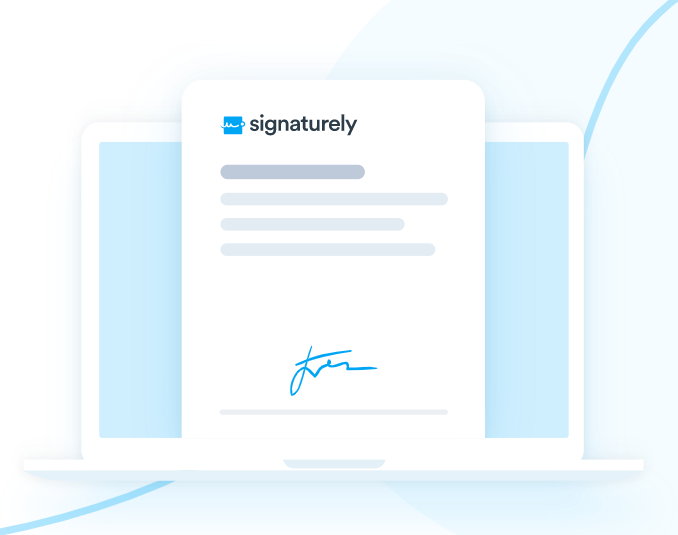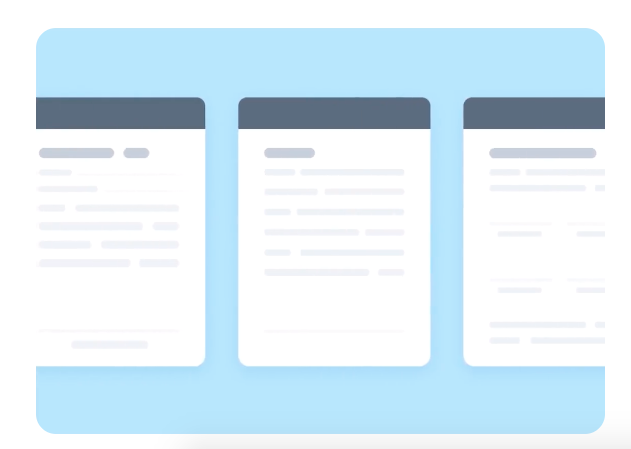In this article, you’ll learn everything about wet signatures and when to use them. You’ll also learn information about the following:
- When wet signatures cannot be replaced
- The benefits and downsides of wet signatures
- Better ways to sign your documents
By the end of the article, you’ll know everything you need about wet signatures and what the alternatives offer.
Let’s get started.
What Is a Wet Signature? Wet Signature Meaning
A wet signature, ink signature, or wet ink signature is a person’s physical marking to sign their name on a physical document, usually with a pen.
Wet signatures are the most common and have been used for centuries as a unique marking to indicate agreement and prevent fraud. Physical signatures have been used since 3500 B.C. in the form of seals, but it was in the 1600s when signatures written on paper became widely used and legally valid.
Although skilled people can forge wet signatures, they were the norm until the beginning of the 21st century, when online signatures became legally binding.
These days, wet signatures are slowly being phased out by online signatures, which can provide better protection and are far more versatile.
When Should You Use a Wet Signature
You can use wet signatures in nearly all situations where you can access a physical document. However, there are a few occasions when wet signatures are irreplaceable.
Some documents require wet signatures, such as certain bank loans, house leases, and other money-related processes.
Since ESIGN (Electronic Signatures in Global and National Commerce Act) involves over 180 countries, a few smaller countries are yet to be included.
Finally, you should use a wet signature when it’s easier to use one, like when you’re writing a contract between friends, and it’s faster to get it signed in person than by email. You may also want to use wet signatures when you’re getting a document signed by a person who’s not very tech-savvy and is uncomfortable signing with anything other than a wet signature.
In short, you should use wet signatures in the few cases when it is required or when using wet signatures is easier than the alternative.
Pros and Cons of Wet Signatures
Here are the benefits and drawbacks of using wet signatures:
Pros of Wet Signatures
Although wet signatures are being used less often, there are a few things that still give them an edge:
Personality and branding
Wet ink signatures can be incredibly powerful when it comes to branding. The Disney logo, for example, is famously modeled after Walt Disney’s wet ink signature.
Wet ink signatures are the obvious choice for autographs too, and any famous person undoubtedly has a carefully-designed wet signature to sign their photos or work when applicable.
Wet signatures also have some warmth and are a must when handwriting a letter because they imprint some personality.
Social and psychological effects
Whereas online signatures are far faster and more effective, wet signatures need the signer to be present, usually with the rest of the signees, to sign a document.
This may help wet signatures have a longer-lasting impact on the signees, and the occasion may also be used for social purposes.
Cons of Wet Signatures
In the modern age, there can be multiple issues when signing with a wet signature, such as:
Forgeries
Forgeries are far too easy when it comes to wet signatures. At the end of the day, the only thing that keeps a wet signature safe is its uniqueness, and even the most convoluted wet signature can be forged with enough practice.
It’s precisely the lack of security in signatures that ended up leading to the main function of notary publics as impartial witnesses in the U.S. government.
And paying a notary isn’t the only thing you’ll end up paying for with wet signatures.
Expensive and inconvenient
Besides notaries, using a wet signature can be quite costly. To start, you’ll have to pay for paper and ink. This isn’t a significant payment unless you must sign multiple documents regularly.
Then, there’s the issue of location. A wet signature needs two witnesses to be legally binding while the relevant parties sign their contracts. That means you need to have at least four people in one room simultaneously, and adding more signers may make the progression more difficult. The inconvenience is only worsened by the time and travel expenses of getting each person to the same location.
This is all assuming all parties are already in the same location. Wet signatures become far harder when the signees are in different locations.
Bad for the environment
Even if you have the money to spend on wet signatures, printing paper, signing, filing, and transporting people in and out of the signing location isn’t great for the environment.
With more companies going paperless, there’s no need to waste resources with a less effective method of signing.
Slow
At best, wet signatures are as fast as online signatures. At worst, they can be far slower.
Your signees must be at the same location to sign a wet signature. However, that’s just the start of the process.
Some signees may want to take a copy to their lawyer. Some signees may want to read the document more carefully. After this, they may want to change or add something to the document, making you start the process from scratch.
And that’s if you don’t need to wait for someone to come from out of town or send the document via snail mail.
Wet Signature vs. Electronic Signature: What’s the Difference?
The first difference between wet signatures and electronic signatures is how they look.
A wet signature is a physical mark that usually resembles the signee’s name in cursive. An electronic signature is a digital change to the document, usually in the form of an added image.
While wet signatures are only as good as the witnesses and the intricacy of the signature, electronic signatures save enough data to prove their legal validity and origin.
Although both signatures prove the intent to fulfill a contract, online signatures are easier, faster, and, in most cases, even more secure than their wet counterparts.
Can You Always Use an Electronic Signature Instead of a Wet Signature?
In general, electronic signatures can be used to sign nearly any document. However, there are still some circumstances when you can’t use an electronic signature.
As we already mentioned, wet signatures are usually required in some cases, especially when there’s money involved. There are also cases of a few dozen countries that have yet to be included in the ESIGN (Electronic Signatures in Global and National Commerce Act).
Even the ESIGN itself preserves the right of a party to accept wet signatures in electronic documentation.
Finally, electronic signatures aren’t as strong as notarized wet signatures. If you want something signed and want to make sure you can prove its validity in court beyond any reasonable doubt, you should always get it signed by a notary. This can be the case with any large money transaction, like buying a house, writing a will, or signing other highly-contested documents.
Why Should You Start Using Electronic Signatures?
Here are a few reasons why you should use electronic signatures:
1. Far easier and more convenient
Signing a document with an electronic signature is usually as easy as opening it, tapping the screen, or clicking a few times and sending it back.
There’s no need to get anything shipped, to travel anywhere, or to get witnesses to your signature. This is perfect when you have signees located worldwide, like when providing service to international customers or hiring remote employees.
If anyone wants their lawyer to take a look at the document, it’s as easy as sending the document to their lawyer in an email for review and approval. Once approved, the person can easily sign the document.
All signers need is access to a device with an internet connection and a couple of minutes.
That’s it.
2. More secure
Although it can be counterintuitive, electronic signatures are generally safer than wet signatures.
But how can electronic signatures be safer without witnesses or unique physical markings?
It all comes down to the data. When a user signs with an electronic signature, the signature saves traceable information about who just signed, when they signed, and where they signed.
Also, there’s no way of changing an online document to alter its meaning or terms once it has been signed. With most online signing platforms, once a document has been sent to be signed, there’s no way to change its contents. And once it’s signed, it’s impossible to change anything on the document for good.
3. Much faster
Signing in person can take a few hours to several weeks, depending on where the signers are and how long they need to retain the document.
Since online signatures can be done by virtually anyone anywhere, there’s no wait time. You also save time on getting started once the document is signed.
Suppose your signed document is a proposal or contract you must fulfill. In that case, you can easily connect your online signing platform with the other tools you’re using to trigger immediate responses and get started with fulfilling your contract immediately.
4. Much cheaper
At a minimum, physical documents require paper and ink. You also require a printer with any maintenance it may need, shipments, copies, and, most importantly, your precious time.
Since you don’t need to print anything or wait for anyone, you can save resources and send many more documents to be signed in the same amount of time.
5. Better user experience
Online signing gives the user a better experience. There’s no need to inconvenience people with appointments or mail. All you need from them is a couple of minutes.
This helps you reach your signers even when they’re on holiday, being driven around, or on a break. And since they can sign faster, you can close the sale or finalize negotiations as fast as they can say “yes.”
Once the document has been signed, there are no papers to file or documents to ship to your legal department. All documents are stored within your online signature platform.
How to Get Started With Electronic Signatures
Here’s how to get started with electronic signatures using Signaturely:
1. Sign up

The first thing you need to do is sign up. You can sign up for Signaturely for free and upgrade if necessary.
All that is required to sign up is your name, email address, and password. Or, if you prefer, sign up using your Google login to start immediately.
2. Upload your document

Once you’ve joined, start by uploading your document. You can upload documents from your computer or connect your cloud server to Signaturely to upload them directly.
2. Creating your contracts

You can easily create one on the platform if you don’t have a document.
Signaturely has 45+ ready-made professional templates written and proofread by legal experts. All you need to do is to find the one that best suits your needs and personalize it.
The free templates include the following:
- SEO Proposal
- Work For Hire Agreement
- Referral Agreement
- Personal Training Contract
- Non-Compete Agreement
- Rental Agreement
- Sales Contract
- Non-Disclosure Agreement
- Marketing Agreement
- Service Agreement
- And 35+ more!
3. Getting signatures

Once your document is ready and uploaded, it’s time to get it ready to sign. To do this, use Signaturely’s integrated editor to add your signature fields.
Choose where you want a wet signature or initials, and add the electronic equivalent with a couple of clicks. You can also select the order in the documents that need to be signed in and include a personalized message.
Once you’re done, simply click “Send.” Signaturely will then send your signees an email and guide them through every step of the signing process, starting with creating their e-signature.
Once the document is signed, there’s no losing it. Signaturely will save the critical data and keep a legal backup of all your documents, in case you need it.
Wet Signature FAQ: All Common Questions and Answers
Here are the answers to the most common questions about wet signatures:
A wet signature, ink signature, or wet ink signature is the physical marking unique to a person. This physical marking is usually used in documents to communicate agreement or compliance.
A wet signature is a physical mark done in person, usually on paper. A digital signature is an electronic marking done on a digital document—the digital equivalent of a wet signature. However, digital signatures can be done remotely on virtually any computer, tablet, and smartphone, whereas wet signatures require the signature to be made in person.
The easiest way to send a wet signature by email is by printing the document, signing it with a wet signature, then scanning it and sending it via email. The ESIGN usually approves this process.
You can use your phone to scan a document with wet signatures so they get digitized. Once the documents are scanned, you can easily send them as digital files.
Conclusion
Although wet signatures used to be the norm, they were quickly phased out by digital signatures, which are faster, easier, safer, and more convenient than wet signatures.
Get started with online signatures by signing up for Signaturely for free today.
